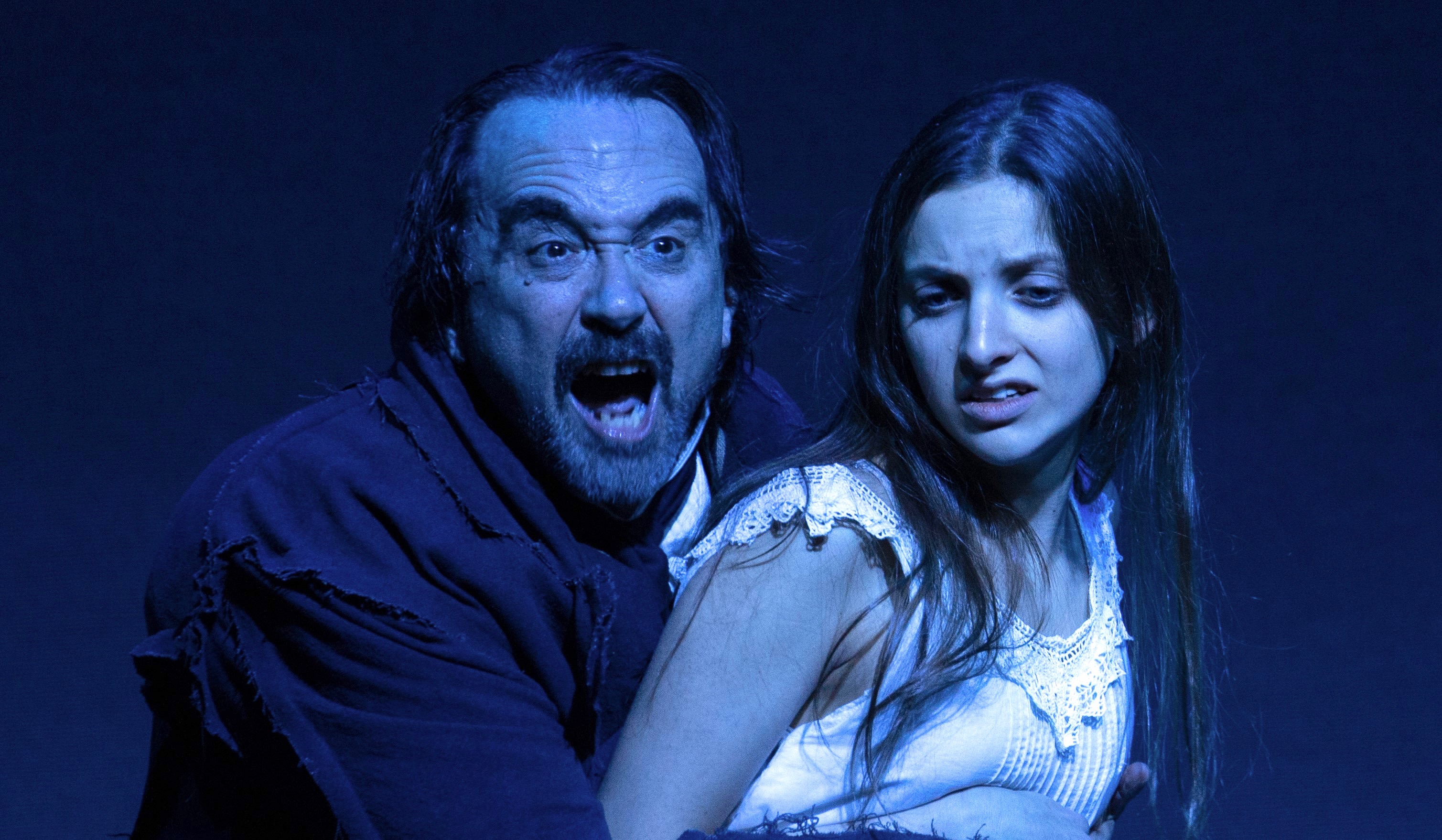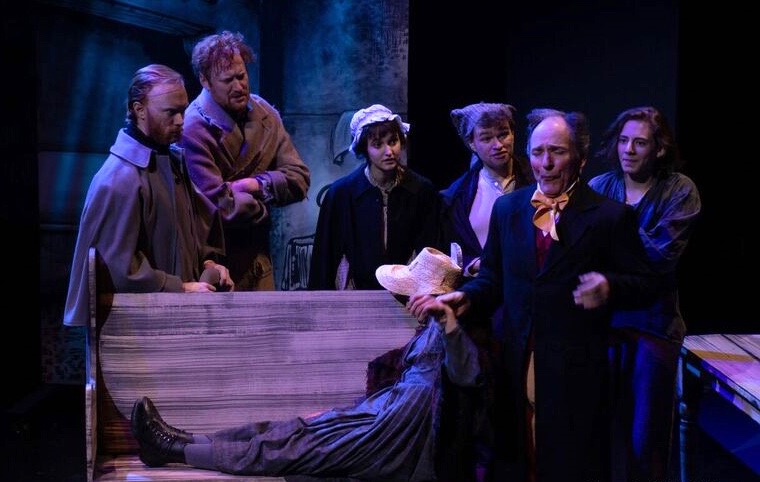PICT’s ‘Old Curiosity Shop’ Is a Curious Experience!

Can Little Nell escape the clutches of evil Quilp? Martin Giles is the mad moneylender and Caroline Lucas is the heart-rending heroine in this stage version of ‘The Old Curiosity Shop.’ (photo: Keith A. Truax)
A while ago, when PICT Classic Theatre announced its 2018-19 season, there were Pittsburgh theater fans who did a double-take at the first play on the schedule. An adaptation of Charles Dickens’ The Old Curiosity Shop? Although the novel was immensely popular in the 1800s, since then it has joined Martin Chuzzlewit in the ranks of lesser-known Dickenses. Many Americans don’t even recognize the title; few have actually read the book.
But some of us like surprises. The Old Curiosity Shop is now playing at PICT (through December 15). And the play comes across—at least to this writer, it did—as a most curious evening of theater. It’s a series of scenes that struggle to add up to a compelling story, but contain numerous flashes of brilliance, which register vividly.
The adaptation is by PICT Artistic Director Alan Stanford, who also directed. The actors, many of them regulars with the company and well known on the Pittsburgh scene, give spot-on portrayals of the colorful characters. A few of my favorites:
James FitzGerald, as the crooked attorney Brass, is so superbly smarmy and serpent-eyed that I’m afraid I’ll see him in my nightmares. Jordon Ross Weinhold—who played a spectacularly silly turn as a daft magistrate in PICT’s Oliver Twist in 2015—has a quieter role here, as good-guy Dick Swiveller. Yet he literally shines, warming the stage with the good cheer he radiates.
And how about drunk scenes: It is easy to act drunk when one is drunk, not so easy if not. Ken Bolden, who plays multiple roles, does a bang-up job of a particular kind of drunk act. He’s the inebriated know-it-all who reels through a touchy situation with just enough clarity of mind to take charge in all the wrong ways.

Horrors: Nell has collapsed, and the hand-holder supervising her critical care—Ken Bolden, in the yellow tie—is a very tipsy gent. (photo: Keith A. Truax)
Altogether, this stage version of The Old Curiosity Shop has plenty of neat stuff to offer. The difficulty in making the pieces add up, I think, comes from the nature of the book it’s based on.
A Book That Keeps On Booking
Dickens wrote the novel in serialized installments. They appeared in his weekly magazine Master Humphrey’s Clock between spring of 1840 and the end of ’41, and it seems he made up much of the story as he went. Hence the title: Dickens first intended The Old Curiosity Shop to be a short thing, set in and around a London shop of that type. Then he kept going until he spun a web interconnected episodes unfolding far and wide, involving multitudes of characters who’d never seen the shop, which vanishes from the tale.
Readers loved it. At the core of the story was the character they rooted for, Little Nell. She was, and remains, an archetypal imperiled heroine of early-Victorian melodrama.
Little Nell is a 13-year-old orphan living with her grandfather, the shopkeeper, a kindly old man whose judgment is flawed. Grandpa has a gambling habit. He falls deep in debt and loses the shop, at which point an odyssey begins. Little Nell and grandfather flee the evil moneylender Quilp. With Nell guarding the meager cash they have left, they wander through towns and countryside in search of a safe haven.
Nor is that all. While Little Nell survives adventures both perilous and humorous—tugging her luckless gamblin’ gramps with her—various parties in addition to Quilp and his minions seek the fugitive pair, for assorted reasons. And of course they’ve each got subplots of their own, cooking in places other than where Nell is at any given time.
The novel gives readers a grand tour of mid-1800s English life. The settings range from posh offices to grim factory towns, a country inn, a racetrack (don’t let grandpa bet on the ponies!), and much more. The whole deal is salted with Dickens’ sharp social commentary, atop a menu of more cliffhanger episodes than you’d think England has cliffs—and try boiling that down to two and a half hours on stage.
A Play That Rambles, Then Tightens
In the program notes which you can read while waiting for the show to start, playwright Stanford admits the task of adaptation was daunting. His Old Curiosity Shop was first performed in Dublin in 2008. The PICT run is its U.S. premiere.
What it mainly brings us, in my view, is the grand-tour quality just mentioned. Using minimal props and effects but a sizable cast of 15—all talented, and a bunch role-hopping—the play presents a cavalcade of vignettes that ramble across the spacious stage. Some are stunning, like the grim factory-town scene. It’s done with the ensemble swathed in drab clothes as poor folks, milling about hunched and haunted in semi-darkness while they chant “Bread, bread … help me, help me …”
And some scenes sparkle bright, floating on snappy repartee. (“That’s the trouble with old people. There’s no trusting them.”) What’s often not so strong is the drive to push the narrative forward, or to pull the diverse narrative streams together; to generate the cliffhanger edge.
The drive does pick up and the edges sharpen in the second act. We have gotten to know the characters. Now they’re converging. As drama, this is when the play is at its best. And the fact that much of the Dickens novel had to be stripped out or altered becomes, I think, an advantage rather than a cause of patchiness. The play gets leaner.
For example, Stanford has made this change: Whereas the novel ends in a convoluted sequence of denouements, PICT’s play closes with a bang.
And what’s the bang? Not telling. That’s The Old Curiosity Shop.
Closing Credits and Ticket Info
Alan Stanford’s The Old Curiosity Shop, adapted from the Dickens novel, has a stellar cast. Along with those already named the actors are Karen Baum, Patrick Conner, Jacob Epstein, Martin Giles, Calema Graham, Matt Henderson, Kaitlin Kerr, Sean Lenhart, Caroline Lucas, Kendra McLaughlin, Jeff Monahan, and last but never least Jonathan Visser.
Through Dec. 15 in the Fred Rogers Studio at WQED, 4802 Fifth Ave., Oakland. For showtimes and tickets visit PICT on the web or call 412-561-6000.
Mike Vargo, a Pittsburgh-based freelance writer, covers theater for Entertainment Central.
Share on Social Media
Follow Entertainment Central
Latest Stories
Sign up for the EC Newsletter







